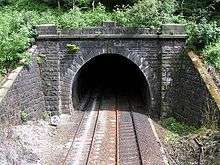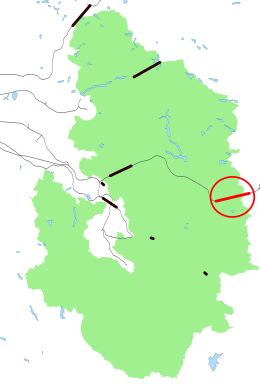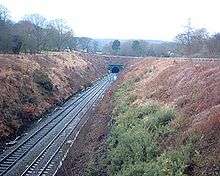Totley Tunnel
Totley Tunnel is a 6,230-yard (3.5 mi; 5.7 km) tunnel on the Hope Valley line between Totley on the outskirts of Sheffield and Grindleford in Derbyshire, England.
 Western portal | |
| Overview | |
|---|---|
| Line | Hope Valley Line |
| Location | Grindleford, Derbyshire |
| Coordinates | 53.311°N 1.585°W |
| Operation | |
| Work begun | 1888 |
| Constructed | Thomas Oliver of Horsham |
| Opened | 1893 |
| Owner | Network Rail |
| Technical | |
| Design engineer | Parry and Storey of Nottingham |
| Length | 6,230 yards (5.70 km; 3.54 mi) |
| Track gauge | 4 ft 8 1⁄2 in (1,435 mm) standard gauge |


Construction
Totley Tunnel was constructed by the Midland Railway on its line between Sheffield and Manchester via the Hope Valley.[1] The engineers were Parry and Storey of Nottingham and the contractor for 10.5 miles (16.9 km) of the railway, including the tunnel, was Thomas Oliver of Horsham, West Sussex. Work began in 1888 with the construction of three brick surveying towers along the tunnel's proposed line, followed by a vertical shafts to the level of the rails. The Duke of Rutland had decreed that no more than one ventilation shaft should be sunk through his land and that work should cease from August to October, during the grouse shooting season. Four permanent and three temporary shafts were sunk near to the Totley end. The latter were cut through shale, and water was encountered in the first eight feet. The permanent shafts took longer, encountering beds of ganister, coal and rock.
As the 10-by-9-foot (3.0 m × 2.7 m) headings were driven from the base of each shaft, water flow increased to 2.25 million imperial gallons (10,200 m3) per day – equivalent to 26 imperial gallons (118 l) per second. At the Padley (Grindleford) end, the situation was little better and work stopped for several weeks until a drain was laid. Then at about 2,000 yards (1,800 m) a spring was encountered which flooded the workings at 5,000 imperial gallons (23 m3) per hour or 1.4 imperial gallons (6.3 l) per second. A raft was used to inspect the workings. Shortly after this the shale became drier and work proceeded toward Totley, the headings finally meeting in 1892.
The tunnel was the proving ground of a number of boring machines for the shot holes, using gelignite to blast the rock. No limit was set on the amount, and in all some 163 long tons (166 t; 183 short tons) were used. The atmosphere in the workings was hot and humid and compressed air used for ventilation. For a time at the Padley end, a turbine was installed in the Burbage Brook to drive a fan.
During construction a natural cavern, several hundred feet in area, was discovered and incorporated into the tunnel and a large air shaft was installed to the surface. The entrance to the cavern can be seen on the Up side (towards Sheffield) of the tunnel halfway through.
Because of the damp conditions, the workforce suffered outbreaks of typhoid, diphtheria, smallpox and scarlet fever. Accommodation was scarce, and the workers lived often twenty to thirty in a house. Working 24-hour shifts, as soon as one man got out of his bed, another would take his place, with little in the way of washing or sanitary facilities.
The tunnel was completed in 1893[2] and at the time was the second-longest railway tunnel in the UK, the older Severn Tunnel is 0.8 miles (1.3 km) longer. Passenger services commenced in 1894.[3] After the two High Speed 1 tunnels opened in 2007, it became the fourth longest mainline railway tunnel in the UK.
Because of its length, in addition to the Midland's normal block system, signal wires were installed which, when cut, caused alarms to ring in the signal boxes at each end. The same system was used in the shorter Cowburn and Clay Cross Tunnels.
From the Hope Valley towards Totley the tunnel starts level, then falls on gradients of 1 in 150, 1 in 176 and 1 in 100.[4][5]
Present day
Totley Tunnel is frequently used by both passenger trains between Sheffield and Manchester[6] and freight lines operating from Hope. The passenger services are Northern who operate a regular stopping service at the Hope Valley stations, Transpennine Express and East Midlands Railway. Above ground, there are a number of ventilation shafts still visible along the Dore and Totley Moss moorland.[7] Several shafts are visible in Dore from Strawberry Lee Road - however safety railings have now been added across the top of the shafts. Additionally, the Western portal is easily observed by hikers at its location in Grindleford.
References
- Regional History of the Railways of Great Britain, Vol VIII, South & West Yorkshire: David Joy: 2nd ed; David & Charles; Newton Abbot; 1984 pp. 170–171
- Labrum, Edward A (1994). Civil Engineering Heritage. Eastern and Central England. London: Thomas Telford Ltd (for the Institution of Civil Engineers). p. 13. ISBN 072771970X.
- Regional History of the Railways of Great Britain, Vol VIII South & West Yorkshire; David Joy; 2nd ed; 1984, David & Charles; Newton Abbot; p. 171
- Nock, O. S. (June 1971). "Some results of route rationalisation". Railway Magazine. Retrieved 18 May 2017.
- British Rail Mainline Gradient Profiles. Ian Allan. pp. M15. ISBN 9780711008755.
- "Live train schedule through Totley Tunnel".
- The Hope Valley Line Dore to Chinley; Ted Hancock; p.112
- Edwards, B., (1985) Totley and the Tunnel, Sheffield, Shape Design Shop
- Plans Relating to Dore & Chinley Railway: Section of strata in heading of Dore and Totley Tunnel, Derbyshire Record Office, File ref. D4107/5/1